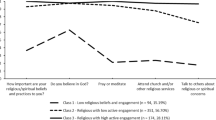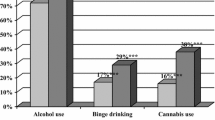Abstract
Religiosity is a protective factor against illicit drug use, but further investigation is needed to delineate which components of religiosity are protective against use. A racially diverse sample (N = 962) was surveyed about religiosity, exposure to users, and recent use of marijuana, powder cocaine, ecstasy, and nonmedical use of opioids and amphetamine. Results suggest that identifying as Agnostic increased odds of use for each of the five drugs; however, this effect disappeared when controlling for religious importance and attendance. High levels of religious attendance were protective against recent use of marijuana and cocaine, but protective effects diminished when controlling for exposure to users, which was a robust predictor of use of every drug. Religion is a protective mechanism against drug use, but this effect may diminish in light of exposure to users. Alternative preventative methods need to be directed toward individuals who are not religious or are highly exposed to users.
Similar content being viewed by others
References
Bahr, S. J., Maughan, S. L., Marcos, A. C., & Li, B. (1998). Family, religiosity, and the risk of adolescent drug use. Journal of Marriage and the Family, 60(4), 979–992.
Bartkowski, J. P., & Xu, V. (2007). Religiosity and teen drug use reconsidered: A social capital perspective. American Journal of Preventative Medicine, 32(6S), S182–S194.
Blendon, R. J., & Young, J. T. (1998). The public and the war on illicit drugs. Journal of the American Medical Association, 279(11), 827–832.
Chen, C.-Y., Dormitzer, C. M., Bejarano, J., & Anthony, J. C. (2004). Religiosity and the earliest stages of adolescent drug involvement in seven countries of Latin America. American Journal of Epidemiology, 159(12), 1180–1188.
Crano, W. D., Siegel, J. T., Alvaro, E. M., Lac, A., & Hemovich, V. (2008). The at-risk adolescent marijuana nonuser: Expanding the standard distinction. Prevention Science, 9(2), 129–137.
Degenhardt, L., Chiu, W. T., Sampson, N., Kessler, R. C., & Anthony, J. C. (2007). Epidemiological patterns of extra-medical drug use in the United States: Evidence from the National Comorbidity Survey Replication, 2001–2003. Drug and Alcohol Dependence, 90(2–3), 210–223.
Ellis, L. (2002). Denominational differences in self-reported delinquency. Journal of Offender Rehabilitation, 35, 185–198.
Franch, M. S. (2008). Spirituality, religion, and meaning. Journal of Nervous & Mental Disease, 196(8), 643–646.
Francis, L. J. (1997). The impact of personality and religion on attitude towards substance use among 13–15 year olds. Drug and Alcohol Dependence, 44, 95–103.
Harrell, Z. A., & Broman, C. L. (2009). Racial/ethnic differences in correlates of prescription drug misuse among young adults. Drug and Alcohol Dependence, 104(3), 268–271.
Herman-Stahl, M. A., Krebs, C. P., Kroutil, L. A., & Heller, D. C. (2006). Risk and protective factors for nonmedical use of prescription stimulants and methamphetamine among adolescents. Journal of Adolescent Health, 39(3), 374–380.
Jackson, K. M., Sher, K. J., & Schulenberg, J. E. (2008). Conjoint developmental trajectories of young adult substance use. Alcoholism, Clinical and Experimental Research, 32(5), 723–737.
Johnson, B. R., De Li, S., Larson, D. B., & McCullough, M. (2000). A systematic review of the religiosity and delinquency literature. Journal of Contemporary Criminal Justice, 16(1), 32–52.
Johnston, L. D., O’Malley, P. M., Bachman, J. G., & Schulenberg, J. E. (2012). Monitoring the Future national survey results on drug use, 1975–2011: Volume II, College students and adults ages 19–50. Ann Arbor: Institute for Social Research, The University of Michigan.
Kandel, D., & Yamaguchi, K. (1993). From beer to crack: Developmental patterns of drug involvement. American Journal of Public Health, 83(6), 851–855.
Kier, F. J., & Davenport, D. S. (2004). Unaddressed problems in the study of spirituality and health. American Psychologist, 59(1), 53–54.
Michalak, L., Trocki, K., & Bond, J. (2007). Religion and alcohol in the U.S. National Alcohol Survey: How important is religion for abstention and drinking? Drug and Alcohol Dependence, 87(2–3), 268–280.
Miller, W. R. (1998). Researching the spiritual dimensions of alcohol and other drug problems. Addiction, 93, 979–990.
Miller, L., Davies, M., & Greenwald, S. (2000). Religiosity and substance use and abuse among adolescents in the National Comorbidity Survey. Journal of the American Academy of Child and Adolescent Psychiatry, 39(9), 1190–1197.
Newport, F. (2006a). Religion Most Important to Blacks, Women, and Older Americans: Self-reported importance of religion decreases with education. Retrieved from http://www.gallup.com/poll/25585/religion-most-important-blacks-women-older-americans.aspx.
Newport, F. (2006b). Who believes in God and who doesn’t? Belief in God correlated with socioeconomic status. Retrieved from http://www.gallup.com/poll/23470/who-believes-god-who-doesnt.aspx.
Newport, F. (2007). Just why do Americans attend Church? Those who don’t attend have variety of reasons for their behavior. Retrieved from http://www.gallup.com/poll/27124/just-why-americans-attend-church.aspx.
Nonnemaker, J. M., McNeely, C. A., & Blum, R. W. (2003). Public and private domains of religiosity and adolescent health risk behaviors: Evidence from the National Longitudinal Study of Adolescent Health. Social Science and Medicine, 57(11), 2049–2054.
O’Malley, P. M., Johnston, L. D., Bachman, J. G., Schulenberg, J. E., & Kumar, R. (2006). How substance use differs among American secondary schools. Prevention Science, 7(4), 409–420.
Palamar, J. J., Kiang, M. V., & Halkitis, P. N. (2011). Development and psychometric evaluation of scales that assess stigma associated with illicit drug users. Substance Use and Misuse, 46(12), 1457–1467.
Palamar, J. J., Kiang, M. V., & Halkitis, P. N. (2012). Predictors of stigmatization towards use of various illicit drugs among emerging adults. Journal of Psychoactive Drugs, 44(3), 1–9.
Palamar, J. J., Mukherjee, P. P., & Halkitis, P. N. (2008). A longitudinal investigation of powder cocaine use among club drug using gay and bisexual men. Journal of Studies on Alcohol and Drugs, 69(6), 806–813.
Paone, D., Heller, D., Olson, C., & Kerker, B. (2010). Illicit drug use in New York City. NYC Vital Signs, 9(1), 1–4. Retrieved from http://www.nyc.gov/html/doh/downloads/pdf/survey/survey-2009drugod.pdf.
Piko, B., & Fitzpatrick, K. M. (2004). Substance use, religiosity and other protective factors among Hungarian adolescents. Addictive Behaviors, 29, 1095–1107.
Regnerus, M. D., & Uecker, J. (2006). Finding faith, losing faith: The prevalence and context of religious transformation during adolescence. Review of Religious Research, 47(3), 217–237.
Sinha, J. W., Cnaan, R. A., & Gelles, R. W. (2007). Adolescent risk behaviors and religion: Findings from a national study. Journal of Adolescence, 30(2), 231–249.
Smith, H. (1963). Do drugs have religious import? The Journal of Philosophy, 61, 517–539.
Smith, T. W., & Kim, S. (2005). The vanishing Protestant majority. Journal for the Scientific Study of Religion, 44(2), 211–223.
Steinman, K. J., Ferketich, A. K., & Sahr, T. (2008). The dose-response relationship of adolescent religious activity and substance use: Variation across demographic groups. Health Education & Behavior, 35, 22–43.
Stolaroff, M. J. (1999). Are psychedelics useful in the practice of Buddhism? Journal of Humanistic Psychology, 39, 60–80.
Substance Abuse and Mental Health Services Administration. (2010). Results from the 2009 national survey on drug use and health: Volume I. Summary of national findings (office of applied studies, NSDUH series H-38A, HHS publication no. SMA 10-4586 findings). Rockville, MD.
Tart, C. T. (1991). Influences of previous psychedelic drug experiences on students of Tibetan Buddhism: A preliminary investigation. Journal of Transpersonal Psychology, 23, 139–173.
The Pew Forum on Religion & Public Life. (2008). US religious landscape survey: Religious beliefs and practices: Diverse and politically relevant, June 2008. Retrieved from http://religions.pewforum.org/pdf/report2-religious-landscape-study-full.pdf.
Viner, R. M., Haines, M. M., Head, J. A., Bhui, K., Taylor, S., Stansfeld, S. A., et al. (2006). Variations in associations of health risk behaviors among ethnic minority early adolescents. Journal of Adolescent Health, 38(1), 55.e15–55.e23.
United States Census. (2012). State and county QuickFacts: New York City, 2010. Retrieved from http://quickfacts.census.gov/qfd/states/36/3651000.html.
Wallace, J. M, Jr, Forman, T. A., Caldwell, C. H., & Willis, D. S. (2003). Religion and US secondary school students. Youth & Society, 35(1), 98–125.
Author information
Authors and Affiliations
Corresponding author
Rights and permissions
About this article
Cite this article
Palamar, J.J., Kiang, M.V. & Halkitis, P.N. Religiosity and Exposure to Users in Explaining Illicit Drug Use among Emerging Adults. J Relig Health 53, 658–674 (2014). https://doi.org/10.1007/s10943-012-9660-3
Published:
Issue Date:
DOI: https://doi.org/10.1007/s10943-012-9660-3




